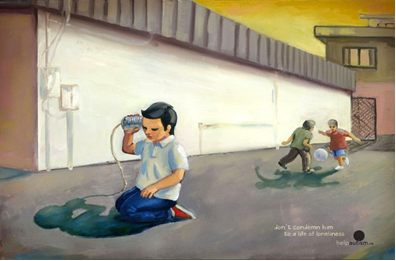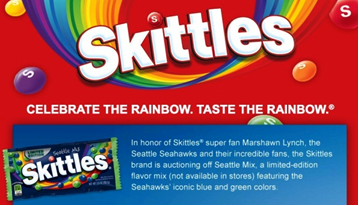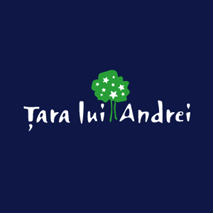Abstract
Considered as figures of speech metaphors are about transferring associations from one experience to another in various fields, from the literary theory to scientific domain, as well. According to Berger (
Keywords: Visual metaphorsprint advertisementsCSR campaigns
Introduction
Metaphors merge two seemingly incompatible images or concepts in an effort to create symbolism.
Metaphors are frequently used in advertising as a way to enhance the perceived value of a product or to
make it seem more personal. They can also help to create a particular brand image. An advertising
metaphor often combines a verbal phrase with a visual image to dramatize the effect. Such comparisons or
metaphors can be portrayed through the use of visuals rather than words. This ability to make such a
strong comparison can be very valuable from an advertiser’s stand point since the visuals in an ad have
been found to be the most important element of an ad in capturing the target’s attention (Pieters & Wedel,
2004).
Generally speaking advertising is used by companies to improve the competitive advantage or to
increase the number of sales or to increase notoriety, as well. Lately an increasing number of companies
are turning to corporate social responsibility which includes social obligations that their business
organizations have towards society: economic responsibilities, legal, ethical and philanthropic ones.
Literature Review
Defining the concept of CSR” Corporate Social Responsibility”
Literally, responsibility means the obligation to respond, to manifest a conscious attitude towards
social obligations. So, a formal definition of the social responsibility involves a manager’s obligation of
integrating in his work projects which should contribute to the individual welfare as much as supporting
the company in the present and in the future, as well.
According to the specialty studies the concept of corporate social responsibility (CSR), finds its
origins in the period between 1930 -1940 being perceived as a field of research a few years later by the
American economist Howard Bowen, who published in 1953 the book entitled "Social Responsibilities of the Businessman" , which provided a first definition of the businessmen social responsibility, namely: "It
refers to the obligations of the businessman to adjust policies, decisions or to follow those lines of action
which are appropriate to the objectives and values of our society"
According to the European Commission in a communication dated October 25th 2011, CSR
represents an essential concept through which, companies contribute voluntarily to improve the living
conditions. In this respect, it is defined as: "Responsibility for all companies on the impact they have on
society."
Another approach comes from WBCSD (World Business Council for Sustainable Development)
which considers that "CSR represents the continuous commitment of the companies to contribute to the
economic development, on the one side, and to improve the life quality of the employees and their
families, and of the society and community, as well”
ISO 26000: 2010 regulates the CSR as being "the responsibility of an organization towards the
impact of its decisions and activities on the society and environment, through transparent behavior and
ethic which contributes to the sustainable development and the society health and welfare; takes into
account the expectations of the parts involved; respect the regulations and it is in concordance to the
international laws; it is integrated into the whole organization and practiced at the level of all relations.
Activities include products, services, processes. Relations refer to the organization activities within its
influence".
Having as starting point the philanthropic dimension which aims aspects which exceed the CSR
economic and legal area, one can state that, the activities performed by a company in view of sustaining
the community development, and of fulfilling the social responsibility assumed, could be divided into five different social programs, with specific benefits, as it follows:
1. Promoting a cause;
2. Philanthropic activities;
3. Volunteering in the community;
4. Marketing related to a cause;
5. Social Marketing.
Corporate social responsibility (CSR) research has represented one of the key strands of research
into organizational management in recent decades (Gond and Matten, 2007; Walsh et al., 2003). This has brought about a change in the paradigm of study for the relationship between the economy, society and
the natural environment. (Marques-Mendes António, Maria João Santos, 2016).
As far as the CSR in Europe is concerned, this became a priority after the Summit of Lisbon
(2000) when the major objective of the European Council has been established, namely that of becoming
the most dynamic and competitive economic system in the world, capable of sustaining the economic
development through better and more jobs, and through higher social cohesion, as well.”
After this summit the European Commission published a paper entitled the "Green Paper" (July
2001) to promote an appropriate CSR framework in Europe. Later on, a written communication called
"Corporate Social Responsibility: A contribution from business organizations to sustainable
development." (July 2002) appeared; according to this, the European Commission proposed a strategy
based on the direction of social responsibility, preparing the Forum held in October, the same year,
regarding the CSR problem in Europe, which has been tasked with promoting the exchange of experience
between companies, and with establishing this topic conduct and evaluation.
Research on the CSR Metaphors. A Model of Explicit Vocabulary Teaching
This literature review is designed to explore and define a method of vocabulary instruction in the
case of CSR metaphors. The current research study will be guided by the following questions: "What
does research say about academic vocabulary instruction that fosters student engagement in academic talk and explicitly teaches word-analysis skills? How can expanded academic talk support academic
vocabulary acquisition?"
Using the guiding research questions, several studies have been chosen to provide extended
interaction and talk for vocabulary acquisition and word-analysis instruction.
As Maria Irene Moreno Rodriguez states in her paper Analysing Metaphors in Commercial
Advertising, "the idea of conceptual metaphors was firstly explored by G. Lakoff and M. Johnson and it
was mainly based on verbal communication as they developed their work 'Metaphors we live by'": (Maria Irene Moreno Rodriguez, 2011, p.109)
"Our conceptual system thus plays a central role in defining our everyday realities. If we are right
in suggesting that our conceptual system is largely metaphorical, then the way we think, what we
experience, and what we do every day is very much a matter of metaphor. (…) In most of the little things
we do every day, we simply think and act more or less automatically along certain lines. Just what these
lines are is by no means obvious. One way to find out is by looking at language. Since communication is based on the same conceptual system that we use in thinking and acting, language is an important source
of evidence for what that system is like “. (Lakoff & Johnson, 1980, p. 124).
Initially, the Conceptual Metaphor Theory (CMT) took into account the fact that it was based on
verbal metaphors. Later on, a series of studies have also demonstrated that metaphors can also occur non-verbally (Grady, 2007) and multimodally (Fauconnier & Turner, 2002). When distinguishing between
monomodal and multimodal metaphors, Forceville states that language can be perceived through two
different modes: (...) “ language can be both perceived visually and aurally. I propose there is good reason to do justice to the important differences between these two manners of perception by giving the status of a different mode to ''written language'' and ''spoken language''. After all, oral and written texts rely on very
different conditions of understanding “. (Maria Irene Moreno Rodriguez, 2011, p.110)
The main goal of the current study is to present an analysis of CSR metaphors used in product
advertisements. In order to carry out this piece of work Forceville’s point of view on metaphors will be
used. According to Forceville (2006), if a product is only advertised visually, it has to be divided into
source and target domain.
Research Methodology
The current study uses the exploratory research on secondary data sources. The research method
has been documentation. In the period 01.02-01.05.2016 there was elaborated a qualitative research
aiming to identifying the importance of promotional campaigns among students. The method used was
based on a structured interview applied to a target group of 25 students from "1 Decembrie 1918
University" of Alba Iulia.
Explicit instructional talk is evident when it directly and intentionally prepares students for their
learning, informs them of the learning path and enables them to develop metacognitive strategies for
knowing that learning has taken place. It engages student thinking for the purpose of learning about
specific aspects of literacy, in our case the CSR metaphors; it responds to student contributions in a way
that makes the connections to specific learning a priority; it responds to students’ contributions in lessons
in a meaningful way that provides scope for them to reformulate ideas, skills and knowledge and
articulate their learning to make real connections to their learning at all stages of the lesson; it also
engages in focused instructional talk.
Objectives:
-Identifying the CSR campaigns which had the highest impact on the target group.
-Identifying and analyzing the given message.
Communication is different in the two cases of products and services. Campaigns differ according
to the purpose to be achieved or to the targeted group. The present research study intended to present
campaigns which, through the message transmitted, aimed to promote a product or to modify attitudes
and behaviors. The essential characteristic of the transmitted message in the very case of CSR is that of
inducing an immediate action of the public, the consumer-product relation being not a direct one in this
respect.
As result of the research conducted, the students’ answers to the question "What is the first
campaign of social responsibility that comes to your mind?" were: "Andrei’s Country Campaign, Made in
Romania and Smile, Romania."
The question "Why you appreciate advertising campaigns" provided the following answers:
message content; modalities of implementation.
Findings
The strongest results for student learning are from studies that incorporate active, extended talk
when learning academic vocabulary. Mercer (1996) sets out to test the linguistic conditions that promote
successful acquisition of academic vocabulary and content. He specifically formulates his study around
the theory that language is social and academic.
Word analysis instruction. The problem of social isolation in the case of children with
autism- Mercury360
Mercury 360 have created a creative print with direct impact for the Help Malin Association,
aiming to make the public aware of their right to recovery services, especially to the social integration
need in the case of children with autism, who are perceived as so lonely and alienated nowadays.

Cognitive analysis:
Metaphor: children with autism are lonely and alienated
Source: image of shadow
Target: child
Modality: monomodal
visual representation of the source
visual representation of the target
The analysis shows that the shadow of the child is the domain source, while the target domains are
the children. The relation between these two items is presented in an explicit way, because the public is
aware of the fact that loneliness can kill children’s soul and transform them into alienated individuals. In
this respect, one can state that our duty is that of helping the children in need, in our case, children with
autism.
Extended Academic Talk. A Partnership Which Encourages the Initiative of Having Breakfast with Family
Cheerios, a brand of cereals of General Mills, broadcast an advertisement in which they announced
their partnership with an initiative that encourages families to have breakfast together.
Cheerios and those from “The Family Dinner Project”, created “The Family Breakfast Project”, a
project in which they tell people that, in the economy of an overwhelming day breakfast can be an
excellent opportunity of spending some time with family members.

In this case we can say that we deal with a group of two children (brothers) trying to prepare the
breakfast and to communicate. It is obvious that they prepare the meal together because of the caption of
the logo "Connect with your family…one meal at a time". As seen in figure
this picture will advertise the product. Consequently, the image has been defined as simple image.
Extended Academic Talk. Skittles-Its Role in The Campaign of Protecting and Educating Children in Need
Skittles engaged that for each point scored by Lynch to donate 10.000 dollars to its foundation,
which was fighting for protection and education of the children in need. Lynch succeeded in scoring to
Super Bowl, and the foundation received its money, with the promise for other to come.
In addition to this, Skittles launched a special edition for Seattle Seahawks fans, with green and
blue candies (team’s colors). The packages have not been sold in supermarkets, but they have been bid
together with personalized football equipment. The funds have been also donated to Lynch Foundation.

Word Analysis Instruction Andrei’s Country (Ţara lui Andrei)
Andrei’s Country (Ţara lui Andrei) is a CSR project of OMV Petrom. For more than four years the
campaign sustains those who know, can and want to inspire their friends in need. The campaign sustains
all those who want to make their own future and to create together a better country every day. Andrei’s
Country trusts its people. It trusts in the power of those who succeed in life by themselves, and trust those who know to guide and inspire them, as well.

Cognitive analysis:
Metaphor: image of the tree guiding and inspiring the others
Source: guiding and inspiring the others
Target: tree
Modality: multimodal verbal representation of the source
visual representation of the target
The characters from Andrei’s Country are not overwhelmed by daily problems; on the contrary,
they choose to solve them. And the difference is made by those who see in each obstacle a new
opportunity of reconstructing the entire world. These are the people who win, through their daily activity,
the title of Honorary Citizens of Andrei’s Country.
Both metaphors from figures
Forceville (2007), a metaphor is considered multimodal when the source domain and the target domain
appear mainly in two different modes. There are various combinations of these kinds of metaphors, but
one of the most frequent is the combination of the pictorial mode and the written mode, as can be
observed in the images mentioned above.
In summary, the research on effective academic vocabulary instruction in what CSR metaphors are
concerned, points towards a model of explicit, context-embedded teaching of the word along with
teaching word-analysis skills. Students who engage in the negotiation of meaning of content, linguistic
forms, and vocabulary show greater gains in vocabulary acquisition and generalized skill transfer.
Moreover, the current research paper demonstrates gains for all those 25 students in the target
group learning vocabulary items with explicit vocabulary instruction comprising word-analysis skills and opportunities for academic talk.
Conclusions
The aim of this paper was to present an analysis of visual metaphors, and to illustrate the existence
of a possible continuum between different types of metaphors in advertising, and especially in the case of
CSR (Corporate Social Responsibility). As shown in the above analysis there is a set of images which
represents a visual metaphor reinforced by the use of language. This particular usage of the language is
essential to understand the metaphor role, but it is never presented as a source or a target domain.
Therefore, it can be concluded that the pictures presenting this pattern must be considered borderline
cases.
Teaching students how to use an academic word, modeling, and providing guided support can
foster increased participation and attendance to desired vocabulary.
To share our findings we plan to dialogue with our colleagues to discuss major pedagogical and
content implications. As teachers, it is our responsibility to provide mainstream teachers with applicable
suggestions for academic vocabulary items and activities to promote student talk, as well.
References
- Berger, A. A. (2012). Seeing is believing, An introduction to visual communication (Fourth edition). McGraw-Hill.
- Bielenia-Grajewska Magdalena (2014), CSR Online Communication: The Metaphorical Dimension of CSR Discourse in the
- Food Industry, in Ralph Tench William Sun, Brian Jones (ed.) Communication corporate Social Responsibility: Perspectives and Practice (Critical Studies on Corporate Responsibility, Governance and Sustainability, Vol. 6 Emerald Group Publishing Limited, p.311 – 333
- Forceville, C. (1996) Pictorial Metaphor in Advertising London and New York: Routledge
- Forceville, C. (2006) Cognitive linguistics: Current applications and future perspectives, Berlin/New York: Mounton de Gruyter
- Forceville, Charles (2007) Multimodal metaphor in ten Dutch TV commercials” Public Journal of Semiotics vol.1, p. 19-51.
- Foropon Cyril Ron McLachlin, (2013), Metaphors in operations management theory building, International Journal of Operations & Production Management, Vol. 33 Iss 2 p. 181-196
- Fareeha Shareef Murugesh Arunachalam Hamid Sodique Howard Davey, (2014), Understanding CSR in the Maldivian context, Social Responsibility Journal, Vol. 10 Iss 1 p. 85 – 114
- Gond, J. P., Matten, D. 2007 Rethinking the Business –Society Interface: Beyond the Functionalist Trap ICCSR Research Paper Series 47-2007, Nottingham University Business School.
- Grady, J. (2007) Metaphor, The Oxford Handbook of Cognitive Linguistics. Oxford: Oxford UP.
- Hiebert, E. & Kamil, M. (2005). Teaching and learning vocabulary: Bringing research to practice. Lawrence Erlbaum: New Jersey.
- Johnson, M. (1987) The body in the Mind: The Bodily Basis of Meaning, Imagination and Reason. Chicago: University of Chicago Press.
- Lakoff, G. & Johnson, M. (1980) Metaphors We Live By Chicago: Chicago University Press
- Marques-Mendes António, Maria João Santos, (2016), "Strategic CSR: an integrative model for analysis", Social Responsibility Journal, Vol. 12 Iss 2 p. 363-381
- María Irene Moreno Rodríguez (2011) Analysing Metaphors in Commercial Advertising, Verbeia Número 1, Grau en Estudis Anglesos , ISSN 2444-1333
- António Marques-Mendes, Maria João Santos and Esther Ortiz-Martínez (2016), Strategic CSR: an integrative model for analysis, Social Responsibility Journal, vol. 12, issue 2, pages 363-381
- Mercer, N. (1996). Language and the guided construction of knowledge. Language and education; Papers from the annual meeting of the British Association for Applied Linguistics held at the University of Southampton, September p. 28-41.
- Mercer, N., & Hodgkinson, S. (2008) Exploring talk in school. London: Sage Publications.
- Oswick Cliff John Montgomery, (1999),"Images of an organisation: the use of metaphor in a multinationalcompany", Journal of Organizational Change Management, Vol. 12 Iss 6 p. 501-523
- Pieters, R., & Wedel, M. (2004). Attention capture and transfer in sdvertising: Brand, pictorial, and text-size effects. Journal of Marketing, 68(2), p. 36-50
- Ronald C. Arnett, (1999),"Metaphorical guidance", Journal of Educational Administration, Vol. 37 Iss 1 pp. 80–89
- Thomaz Wood Jr, (2002),"Spectacular metaphors", Journal of Organizational Change Management, Vol. 15, Iss 1 pp. 11-20
- Walsh, J. P., Weber, K., & Margolis, J. D. 2003. Social issues and management: Our lost cause found. Journal of Management, 29, p. 859–881
- CSR: Meeting changing expectations http://www.wbcsd.org/work-program/business-role/previous-work/corporate-social responsibility.aspx
- ISO 26000 http://www.societal.ro/ro/comunitate/articole/standardul-de-responsabilitate-sociala-iso-26000-433.html
Copyright information

This work is licensed under a Creative Commons Attribution-NonCommercial-NoDerivatives 4.0 International License.
About this article
Publication Date
25 May 2017
Article Doi
eBook ISBN
978-1-80296-022-8
Publisher
Future Academy
Volume
23
Print ISBN (optional)
-
Edition Number
1st Edition
Pages
1-2032
Subjects
Educational strategies, educational policy, organization of education, management of education, teacher, teacher training
Cite this article as:
Mureşan, M., & Pastiu, C. A. (2017). Metaphors Role In The CSR (Corporate Social Responsibility) Campaigns. In E. Soare, & C. Langa (Eds.), Education Facing Contemporary World Issues, vol 23. European Proceedings of Social and Behavioural Sciences (pp. 1819-1827). Future Academy. https://doi.org/10.15405/epsbs.2017.05.02.223

